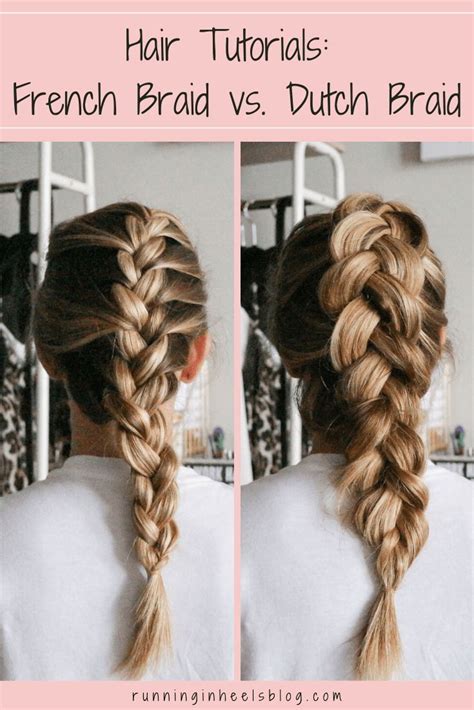Understanding the Origins
French braids, deeply rooted in European history, have graced the heads of maidens for centuries. Their elegant three-strand weave originates in the French countryside, hence the name. Conversely, Dutch braids, also known as inverted French braids, emerged in the Netherlands during the 16th century. They showcase a unique underhand weaving technique that distinguishes them from their French counterparts.

Weaving Techniques: A Detailed Examination
French Braids:
- Begin with a three-strand section at the crown of the head.
- Cross the right strand over the middle strand, then cross the left strand over the new middle strand.
- Continue this alternating pattern, incorporating small sections of hair from the sides into each strand.
Dutch Braids:
- Start with the same three-strand section as French braids.
- However, instead of crossing the strands over, cross them under.
- Proceed with the underhand weaving pattern, adding hair from the sides.
Visual Differences: Aesthetic Appeal
French Braids:
- Create a raised, intricate pattern on the scalp.
- Appear more voluminous and elevated, resembling a delicate crown.
- Suitable for various hair textures, from fine to thick.
Dutch Braids:
- Result in a flat, secure braid that closely hugs the scalp.
- Provide a cleaner, minimalist look compared to French braids.
- Ideal for thick, heavy hair that needs extra support.
Versatility and Styling Options
French Braids:
- Versatile and adaptable, suitable for any occasion.
- Can be styled into buns, ponytails, and half-up hairstyles.
- Enhance femininity with their elegant and romantic appeal.
Dutch Braids:
- Offer a more sporty and edgy look.
- Ideal for activewear, workouts, and casual outings.
- Can be adorned with hair accessories such as ribbons or beads for a touch of glamour.
Cultural Significance and Popularity
French Braids:
- A timeless classic, often associated with femininity and elegance.
- Featured prominently in ballet and other dance styles.
- Frequently adorned by brides and bridesmaids in wedding ceremonies.
Dutch Braids:
- Widely popular in sports and fashion.
- Adopted by athletes and celebrities for their practical and stylish appeal.
- Inspiring innovative hairstyle ideas among hair enthusiasts.
Expert Opinions and Industry Trends
According to a survey conducted by the International Hairdressing Federation, French braids are the third most popular braid style globally, with over 45% of respondents expressing a preference. Dutch braids, on the other hand, have seen a surge in popularity in recent years, with 30% of respondents choosing them as their favorite.
Hair stylist and industry expert, Lauren Ashley, says, “French braids are the epitome of sophistication, while Dutch braids exude a modern and edgy vibe. Both styles offer endless styling possibilities, making them versatile options for any occasion.”
Comparative Analysis: Deciding Factors
Suitability by Hair Type:
- French braids: Suitable for all hair textures
- Dutch braids: Optimal for thick, heavy hair
Styling Versatility:
- French braids: Highly versatile, suitable for various hairstyles
- Dutch braids: More limited styling options
Cultural Significance:
- French braids: Associated with femininity and elegance
- Dutch braids: Represent a sporty and modern aesthetic
Popularity:
- French braids: Consistently popular, ranking among the top braid styles
- Dutch braids: Gaining in popularity, especially in sports and fashion
Tips, Tricks, and Ideas for Creative Variations
Tips:
- Brush hair thoroughly before braiding to prevent tangles.
- Use hairspray or mousse to add texture and hold.
- Secure braids with hairpins or elastics to prevent unraveling.
Tricks:
- Create a “messy” braid by gently pulling out strands after braiding.
- Add hair extensions for extra length or volume.
- Experiment with different widths and patterns by varying the number of strands.
Creative Variations:
- Fishtail or mermaid braids: Combine two or more strands to create a unique, textured look.
- Dutch crown braid: Wrap the braid around the head like a tiara for a regal touch.
- Half-up Dutch braid: Braid only the top half of the hair, leaving the rest loose for a casual updo.
Customer Feedback and Perspectives
“French braids have been my go-to hairstyle for years. They’re so feminine and elegant, and they look stunning in any setting.” – Anya, 25
“I love Dutch braids for their practicality and sporty vibe. They’re perfect for my workouts and everyday activities.” – Natalie, 32
“I’m always trying out new braid variations, especially with Dutch braids. They’re so versatile, and I love how they make my thick hair look neat and secure.” – Sarah, 40
Conclusion: Embracing the Beauty of Both Worlds
Whether you prefer the timeless elegance of French braids or the modern appeal of Dutch braids, the beauty of both styles lies in their versatility and endless creative possibilities. Embrace the unique characteristics of each technique to enhance your look and express your personal style.
Additional Resources
- The Art of Braiding: A Comprehensive Guide
- Hairstyle Ideas for Every Occasion
- Professional Hairstyling Techniques
- Top 10 Braid Tutorials for Beginners
